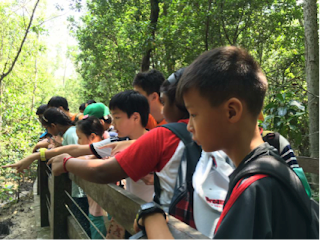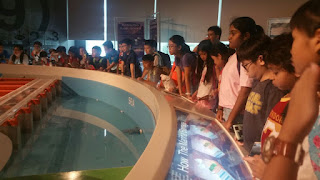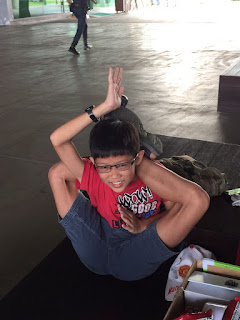Every March and December, we do our best to
plan outdoor activities for our students over the holidays as we believe that
learning should not be confined to the four walls. Learning can be fun and the
student’s senses come alive when they learn outdoor, completing missions!
So if you are planning for a fun activity with your child, here's an idea of what you can do.
There are 3 places in Singapore that are
PRIMARY SCHOOL SCIENCE FRIENDLY. Even when you do not know what to do, just
bring your kids there and the information board will guide you on what to do!
1. March ISUN EXPERIENTIAL DAY @
Pasir Ris Park
Plan your visit: https://www.nparks.gov.sg/~/media/nparks-real-content/gardens-parks-and-nature/diy-walk/diy-walk-pdf-files/pasir_ris_park_guide.pdf?la=en
Worthy trip indication: 10/10
Time: 9.30am-5.30pm
Experiential Day was first started 2 years ago,
and it was held in Gardens by the Bay.
Last year, we brought our lovely ISUN Warriors
to the Far East---- PASIR RIS PARK! :) A place where none of them have been before. And BAAAAM! It
turned out to be awesome fun. It was really great to see all of the kids having
a smile back --- learning with high energy and great teamwork, just like one
big family.
And of course, it's such heartwarming to have
our alumni Isun students coming back as volunteers. They had changed so much,
and we saw how much leadership potential they had from the way they led and
guided the little ones.
What an awesome day out and thank you so much
to our amazing kids, great student facilitators, and hardworking coaches for
creating a different learning experience and bringing a smile back to every
single kid. WOOOHOOOO!
 |
| What are they busy spotting? The answer is in the next picture! |
 |
| Crabs and mudskippers! At the swamp observation area, you will get to spot lots of crabs and mudskippers! |
 |
| Missions at the park :) |
 |
| Horseshoe crab's corpse spotted |
 |
| Praying mantis too! |
 |
| There are lots of information boards all around the swamp area to let us learn about the adaptations of plants and animals. |
 |
| There's a very fun MAZE area. Their mission at the area - grab all the numbers & signs in the maze and form an equation with what they have gotten. |
 |
| ISUN Woohoo~~ |
 |
| We had a fun day together, with lots of 'surprise' appearance... All the wildlife. There is even a wild chicken walking around in the park. |
2. ISUN Headstart Program @ Gardens by
the bay
Plan your visit: http://www.gardensbythebay.com.sg/en/plan-your-visit/gardens-map.html
Worthy trip indication: 10/10
ISUN headstart program consist of 3 days
Day 1 - Outdoor learning trip
Day 2 - Revision of current year topics
Day 3 - Headstart of following year topics
Gardens by the Bay is our all time favourite. We had brought our students there during different years on different programs. The first year's outdoor experience with the first batch of students was held here. At the different regions, you get to learn about different types of plants from different parts of the world. This is the best place to learn about DIVERSITY OF PLANTS ! and PLANT ADAPTATIONS! :)
Of course, in our headstart program, it's not just about science. The students get to learn Math and English as well. Scroll the pictures below (a lot more pictures are on our ISUN Facebook!)
 |
| Missions for the 4 Avengers Team |
 |
| Serious about their Bingo mission |
 |
| Piece the puzzles |
 |
| Friendly ISUN Warriors giving 'Hi-5' to the tourist. |
 |
| Measuring the fire extinguisher box to calculate Area & Perimeter (P4 concepts) |
 |
| Mangrove seeds & how its shape is adapted to plant into the soil for Germination. |
 |
| Reproduction of flowering plants: Female parts |
 |
| More plant samples at the fruits and flowers area. |
 |
| Completing their worksheet after learning from the information board. |
 |
| Completing the BINGO mission :) |
3. ISUN Headstart Program @ Marina Barrage
Plan your visit: https://www.pub.gov.sg/marinabarrage/ssg
Worthy trip indication: 10/10
Worthy trip indication: 10/10
Another venue we explored was Marina Barrage. You can visit the marina barrage gallery and even book their tour! We booked the tour with our students, thereafter, complete our missions relating to the topic.... WATER CYCLE of course!
We traveled from Barrage --> gardens by the bay --> marina bay sands (end point)
Although tiring for both the students and us, but it was definitely worth it. Especially when our students look back and remember that their holiday program was fun and spent in a different way.
We are happy too... because we serve the mission of putting the smile back into learning :)
We traveled from Barrage --> gardens by the bay --> marina bay sands (end point)
Although tiring for both the students and us, but it was definitely worth it. Especially when our students look back and remember that their holiday program was fun and spent in a different way.
We are happy too... because we serve the mission of putting the smile back into learning :)
 |
| Team work- understanding that: To go fast - you run alone To walk far- you walk TOGETHER |
 |
| Start of our tour |
 |
| Look how curious our kids are! They are waiting for the demonstration to begin! |
 |
| This segment showcases sustainable living |
 |
| First station at gardens by the bay - learning about Decomposers |
 |
| What are they looking at? Canon ball tree - the fruits which looks like canon ball undergo seed dispersal by splitting |
 |
| Observing the leaf patterns |
 |
| Random group picture |
 |
| Team cheer :) After one full day, they are fully pumped up... & of course, opened up. |
Other areas we have explored are:
- Labrador park (not child friendly because of the slopes and steep terrains)
Worthy trip indication: 7/10
- Jacob ballas children's garden (this is a good place for science! however, as we have to plan for other subjects such as English and Math, this place is not so suitable for our event)
Worthy trip indication: 9/10
- Punggol park (Rich history of Punggol is showcase near the mall area. As you explore further, there is a small nature park area, small playground area and many bridges. I personally do not like this place as much as the rest as not much wildlife will be spotted here.)
Worthy trip indication: 7/10
Worthy trip indication: 7/10
If you do not have the time to plan for the outdoor experience with your child... Leave it to us :)
ISUN Headstart Program 2017 @ Kallang Wave Mall
This year, we have planned it slightly differently for our students. It's not in a park, but they get to learn through various activities held in that area.
Headstart program is specially designed for students to gain an unfair advantage over other students through fun and engaging activities. This is for parents who are looking at learning beyond tuition and classroom. Students will get to familiarise themselves with new topics for the next academic year. In addition, there will be a revision of the current year's critical topics to strengthen the students' foundation.
Click here for the 2018 P5 headstart program outline:
$250 for 3 days program
Day 1- 8 hours
Day 2 - 3 hours
Day 3 - 3 hours
Click here for the 2018 P6 headstart program outline:
$300 for 3 days program
Day 1- 8 hours
Day 2 - 3 hours
Day 3 - 3 hours
Have fun!






Comments
Post a Comment